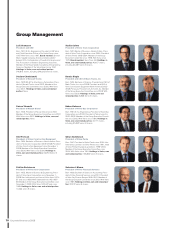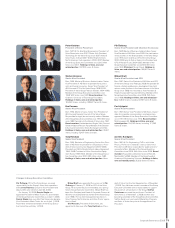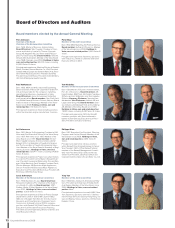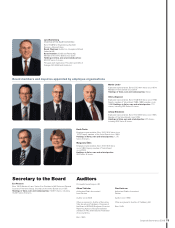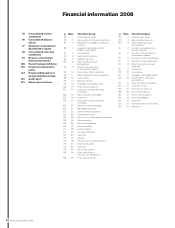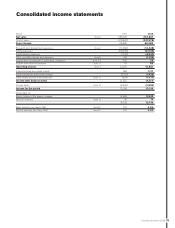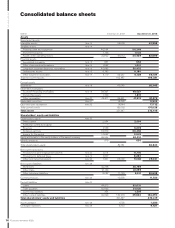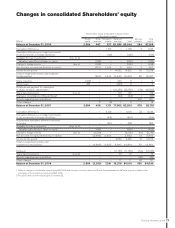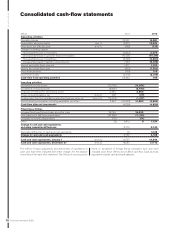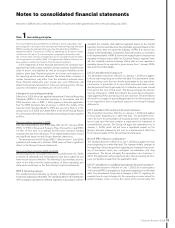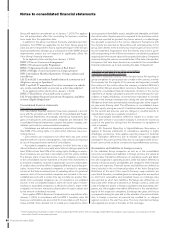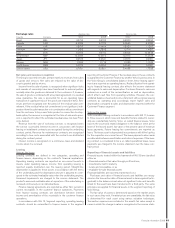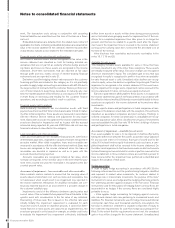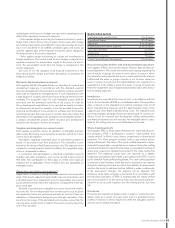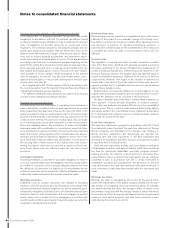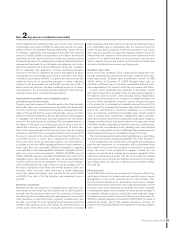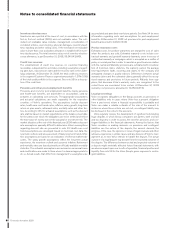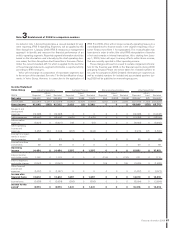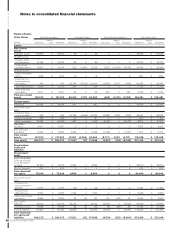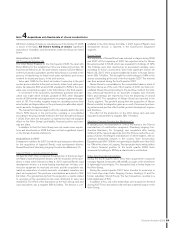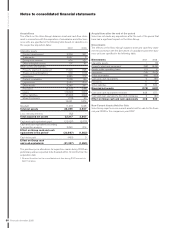Volvo 2008 Annual Report Download - page 84
Download and view the complete annual report
Please find page 84 of the 2008 Volvo annual report below. You can navigate through the pages in the report by either clicking on the pages listed below, or by using the keyword search tool below to find specific information within the annual report.
80
THE VOLVO GROUP
Financial information 2008
Notes to consolidated fi nancial statements
Group will apply the amendment as of January 1, 2010. The applica-
tion will prospectively affect the accounting for business combina-
tions made from the application date.
In addition to the above-mentioned, the below standards and inter-
pretations from IFRIC are applicable for the Volvo Group going for-
ward, but are not expected to have a signifi cant impact on the Group’s
fi nancial statements. Changes as a consequence of the IASB’s annual
improvements project are not expected to signifi cantly affect the
Volvo Group’s fi nancial statement.
To be applied by Volvo starting from January 1, 2009:
IFRIC 12 Service Concession Arrangements*
IFRIC 13 Customer Loyalty Programmes
IFRIC 15 Agreements for the construction of Real Estate*
IFRIC 16 Hedges of a net investment in a foreign operation*
IFRS 2 amendment Sharebased payments: Vesting conditions and
cancellations
IAS 32 and IAS 1 amendment Puttable fi nancial instruments and
obligations arising on liquidation*
IFRS 1 and IAS 27 amendment Cost of an investment in a subsidi-
ary, jointly-controlled entity or associate on a fi rst time adoption*
To be applied by Volvo starting from January 1, 2010:
IFRIC 17 Distribution of non-cash assets to owners*
IAS 39 amendment Financial instruments: Recognition and Meas-
urement: Eligible Hedged items*
Consolidated fi nancial statements
Principles for consolidation
The consolidated fi nancial statement have been prepared in accord-
ance with the principles set forth in IAS 27, Consolidated and Separ-
ate Financial Statements. Accordingly, intra-Group transactions and
gains on transactions with associated companies are eliminated. The
consolidated fi nancial statements comprise the parent company, sub-
sidiaries, joint ventures and associated companies.
– Subsidiaries are defi ned as companies in which Volvo holds more
than 50% of the voting rights or in which Volvo otherwise has a con-
trolling interest.
– Joint ventures are companies over which Volvo has joint control
together with one or more external parties. Joint ventures are reported
by use of the proportionate method of consolidation.
– Associated companies are companies in which Volvo has a sig-
nifi cant infl uence, which is normally when Volvo’s holdings equals to at
least 20% but less than 50% of the voting rights. Holdings in associ-
ated companies are reported in accordance with the equity method.
The Group’s share of reported income in such companies is included
in the consolidated income statement in Income from investments in
associated companies, reduced in appropriate cases by depreciation
of surplus values and the effect of applying different accounting prin-
ciples. Income from associated companies is included in operating
income as the Volvo investments are of operating nature. For practical
reasons, most of the associated companies are included in the con-
solidated accounts with a certain time lag, normally one quarter. Divi-
dends from associated companies are not included in consolidated
income. In the consolidated balance sheet, the book value of share-
holdings in associated companies is affected by Volvo’s share of the
company’s net income, reduced by depreciation of surplus values and
by the amount of dividends received.
Volvo applies IFRS 3, Business Combinations for acquisitions after
January 1, 2004, in accordance with the IFRS 1 transition rules. All
business combinations are accounted for in accordance with the pur-
chase method. Volvo decided not to restate prior acquisitions. Volvo
values acquired identifi able assets, tangible and intangible, and liabil-
ities at fair value. Surplus amounts compared to the purchase consid-
eration are reported as goodwill. Any lesser amount, so-called nega-
tive goodwill, is reported in the income statement. Transactions with
the minority are reported as transactions with external parties to the
group. Divestments to the minority may result in gains or losses in the
income statement. Acquisitions from the minority may result in good-
will corresponding to the difference between considerations paid and
acquired part of net asset value in the acquired subsidiary. Companies
acquired during the year are consolidated as of the date of acquisition.
Companies that have been divested are included in the consolidated
fi nancial statements up to and including the date of divestment.
Translation to Swedish kronor when consolidating
companies using foreign currencies
AB Volvo’s functional currency is the Swedish krona. All reporting in
group companies for group purposes is made in the currency, in which
the company has the majority of its revenues and expenses; normally
the currency of the country where the company is located. AB Volvo’s
and the Volvo Group’s presentation currency is Swedish kronor. In pre-
paring the consolidated fi nancial statements, all items in the income
statements of foreign subsidiaries and joint ventures (except for sub-
sidiaries in highly infl ationary economies) are translated to Swedish
kronor at the average exchange rates during the year (average rate).
All balance sheet items are translated at exchange rates at the respect-
ive year-ends (closing rate). The differences in consolidated share-
holders’ equity, arising as a result of variations between closing rates,
for the current and previous year are charged or credited directly to
shareholders’ equity as a separate component.
The accumulated translation difference related to a certain sub-
sidiary, joint venture or associated company is reversed to income as
a part of the gain/loss arising from the divestment or liquidation of
such a company.
IAS 29, Financial Reporting in Hyperinfl ationary Economies, is
applied to fi nancial statements of subsidiaries operating in highly
infl ationary economies. Volvo applies reporting based on historical
value. Translation differences due to infl ation are charged against
earnings for the year. Currently, Volvo has no subsidiaries with a func-
tional currency that could be considered a hyperinfl ationary currency.
Receivables and liabilities in foreign currency
In the individual Group companies as well as in the consolidated
accounts, receivables and liabilities in foreign currency are valued at
closing rates. Translation differences on operating assets and liabili-
ties are recognized in operating income, while translation differences
arising in fi nancial assets and liabilities are charged to other fi nancial
income and expenses. Financial assets and liabilities are defi ned as
items included in the net fi nancial position of the Volvo Group (see
Defi nitions at the end of this report). Currency swap contracts are
reported at fair value, unrealized gains on exchange rates are reported
as short term receivables and unrealized losses on exchange rates
are reported as short term liabilities. Exchange rate differences on
loans and other fi nancial instruments in foreign currency, which are
used to hedge net assets in foreign subsidiaries and associated com-
panies, are offset against translation differences in the shareholders’
equity of the respective companies. Exchange rate gains and losses
on payments during the year and on the valuation of assets and liabil-
ities in foreign currencies at year-end are credited to, or charged
against, income in the year they arise. The more important exchange
rates applied are shown in the table on the next page.
* These standards/interpretations have not been adopted by the EU at this time. Accordingly, stated dates for adoption may change as a consequence of deci-
sions within the EU endorsement process.


